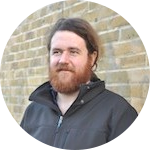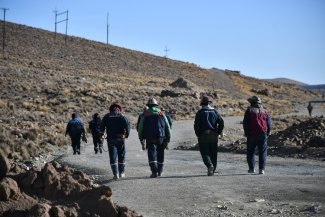
In this photo taken on 10 October 2015, residents who were relocated from a drought-affected region elsewhere in the country sort out maize stalks at their new home in Hongbusi in northwestern China’s Ningxia Hui autonomous region.
While US President Donald Trump may not believe that climate change is a result of human activity – a position which flies in the face of decades of scientific research – one thing is undeniable and that’s the devastating impact of soaring temperatures on people and communities across the world.
In 2016, for example, Pakistan and India were hit by a heatwave which saw temperatures peaking at 51°C, posing a major threat to human life, according to Asad Rehman, a senior international climate campaigner with Friends of the Earth.
“When these heatwaves reoccur the government has to ask itself what it can do: the only answer is dig more mass graves.”
Rehman was addressing a sold-out London conference about climate refugees held on 12 February, organised by the UK’s Campaign against Climate Change and Friends of the Earth. It was the first convergence of both trade unions and civil society on the subject in Europe.
The term ‘climate refugees’ describes those people who are directly affected by immediate climate impacts such as flooding or droughts, but also the knock-on effects of climate change.
For instance, a severe drought in Syria has been identified as one of the underlying causes of the civil war, which according to the United Nations has created over six million internally-displaced people and nearly five million refugees.
And we will only see more of this, say climate experts.
Globally, one person is displaced every second as a result of climate-related disasters, according to figures from the Internal Displacement Monitoring Centre. Rehman also drew attention to examples such as Typhoon Haiyan in the Philippines, which displaced 4.1 million people in 2013, and the current drought in Sahel, which has pushed 23 million into food insecurity.
However, even though the UN predicts that climate change will displace at least 250 million people by 2050, climate refugees are not recognised or protected by international law.
Opening the conference, Joanna Haigh – a professor of atmospheric physics at Imperial College London and co-director the Grantham Institute for Climate Change – shared some alarming statistics: for example, the world is now, on average, 1.1°C warmer than it was before the industrial revolution, something which has caused sea levels to rise, as well as droughts and extreme weather to intensify.
If business continues as usual, global temperature averages will rise by an intolerable 5°C, said Professor Haigh, which would be catastrophic. But even if humans can limit global warming to an average of 2°C we will still face heatwaves, floods, water stress and crop failure.
An increase in mass migration, xenophobia and racism
One of the major responses to this – as we are already seeing – is mass migration from areas badly affected to climate change, mainly in the Global South, to more prosperous countries in the Global North.
A December 2016 report by ActionAid titled Climate Change Knows No Borders, asserts that when natural disaster or conflict strikes, men are more likely to cross international borders, while women often move within states, becoming internally displaced and exploited. Water stress and depleted harvests in rural Bangladesh, for example, pushed many women to work in the garment industry. Many of the 1,134 victims of the 2013 Rana Plaza factory collapse in Bangladesh were internal migrants with this background.
The conference also looked at how trade unions and civil society are tackling the global rise in racism and xenophobia, which is in part a response to the increase in global migration.
Whether its people from central and south America facing the walls, fences and racist policies of President Trump in the United States or African migrants drowning in the Mediterranean while fleeing poverty and conflict, the conference repeatedly looked at the way in which those who gain the least from the current economic system have the most to lose as a result of living on the frontline of climate change.
The populations of the Global South did the least to cause the climate change and at the same time, have the least resources to deal with its disastrous impacts. By contrast, peer-reviewed research by climate specialist Richard Heede shows that 90 corporations – mostly based in Europe and North America – are responsible for 63 per cent of the world’s cumulative carbon emissions.
“Multinational companies restrict resources, they create the climate chaos for so many of the world’s population and they are also the very people at the top of society,” Zac Cochrane from the Stand Up To Racism campaign told the audience. “Their answer to restricting resources is to whip up the type of racism that enables Donald Trump to come to power.”
He called on ordinary people to resist the walls and racist policies of demagogues and populists all over the world, including Europe where over 5,000 people died crossing the Mediterranean last year alone, and millions are spent on border security and push-backs under the European Union’s Frontex programme.
Unions and climate change
When it comes to the role that trade unions should play in tackling climate change, the traditional idea that a green economy is a threat to workers’ jobs is something that unions are tackling head on, said Diana Holland, the deputy secretary general of Unite the Union in the UK.
“I am fed up [of people] saying ‘What about the workers?’, ‘What about equality or the environment?’. That is not how we should be approaching this…all those things are interrelated and they affect everyone.”
Around the rallying cry ‘There are no jobs on a dead planet’, the International Trade Union Confederation (ITUC) has led the global labour response against climate change by calling on governments to choose a zero carbon future and manage a Just Transition to green jobs, skills training and other provisions to mitigate against the effects of climate change in the poorest and most vulnerable communities.
As Chidi King, head of the equality department at the ITUC, explained: “You cannot talk about a world that eradicates poverty with a carbon economy, it is just not possible. So we have established a Just Transition Centre [launched during the 2016 COP22 climate talks in Marrakesh] that brings trade unionists with civil society, activists and employers together with governments to engage in a series of dialogues about how we make the transition to a greener economy.”
One of the final themes of the conference focused on creating more public solidarity for refugees, including those driven by the impact of climate change. But there were no illusions that gaining legal recognition and protection for climate refugees would be easy.
In 2015, then US Secretary of State John Kerry predicted that climate refugees would receive recognition soon. When that will happen is still uncertain but the bigger question is how this recognition will be framed. Will it mean protection and rights, or walls and persecution? One of the strongest possible avenues to protect climate refugees is the so-called Warsaw Mechanism, which was established during COP19 and forms part of the Paris Climate Agreement.
There are also voluntary initiatives such as the Nansen Initiative started by Norway and Switzerland in 2013, where over 100 countries have sought to share best practice to deal with climate refugees.
But an essential message from the conference was that progressive legal changes and social protection are won from the bottom-up. Social movements for the environment, workers’ rights and human rights must intersect around the victims of climate change.









